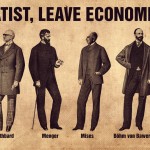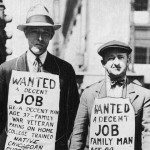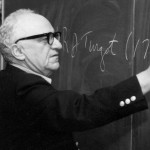
Today is the beginning of concurrent lectures so I had some options but these are sessions I settled on. I skipped note-taking on a Jeff Herbener lecture about banking since that’s going to overlap with Roger Garrison’s talks later this week on the business cycle and Hayek and Keynes, which I will discuss here. Peter Klein had some fascinating comments on the minimum wage and monopsony (a market situation in which there is only one buyer – usually for labor) towards the end of his lecture, but the bulk of his lecture was difficult to replicate here given his use of charts and graphs.
Lecture 1 – Common Objections to Capitalism by Tim Terrell
Lecture 2 – Calculation and Socialism by Joe Salerno
Lecture 3 – Economics of War by McCaffrey
Lecture 4 – Myths of Market Failure by Tom DiLorenzo
For readability’s sake, I’m going to try and change the format a little from yesterday’s post and focus a bit more on the big ideas and my personal experience of each lecture. I won’t deprive you of the details, but I don’t want you staring down a 2,500 word wall of notes. As I mentioned in my original post some weeks ago, I first participated in Mises U when I was a college sophomore. I traveled down to the Mises Institute, next to the campus of Auburn University, and stayed the week in the dorms. That was a turning point in my economics education. But it’s been 10 years and I don’t have the ideological commitment I once did to libertarianism. So I’m going to wear my skeptical hat today. For most of my late 20s I identified as a left-leaning libertarian. I maintained my anti-war position and saw most business regulation as special interest-driven, but I also recognized a practical benefit to supporting local social welfare programs, public schools, libraries, and the like.
Lecture 1 – Common Objections to Capitalism by Tim Terrell
Terrell notes that some folks object to using the term “capitalism,” as it can lead to come confusion, and that often what detractors mean by that word is in fact “crony capitalism” and not the free-market, where certain interests and groups are able to avoid the consequences of their actions because of their connection to the state and the special privileges they’re granted. He also mentions that defending human freedom is a bit like playing whack-a-mole, as there’s always some new “reason” popping up as to why the central state needs more power.
The rich get richer and the poor get poorer
Terrell argues that the nature of the free-market is one of production and innovation. He cites a statistic: of Americans designated as poor, 99% have electricity, running water, flush toilets, telephones…etc. Cornelius Vanderbilt had none of these. An important distinction in this conversation: are we discussing inequality or the real well-being of the poorest of society? Terrell notes that increased immigration will tend to result in increased inequality even though no one is actually worse off – indeed, many folks will be better off relative to their previous living situation.
Terrell notes that it’s okay to be concerned about inequality, but that we should recognize how certain government programs tend to increase inequality despite their stated intentions. In some states, welfare pays more than a minimum wage job, in 13 states it pays more than a $15 per hour job (he cites a study from Tanner and Huges (2013) and offers a number of graphs to bolster his numbers – I think this question deserves its own lecture). The upshot is that with welfare programs in place, after taxes, your income isn’t going to go up very much if you find employment. The loss of welfare benefits has a similar behavioral effect as taxes on income. When you couple these together – both the loss of benefits and the added taxes for added income – a low-income earner has to make a single enormous leap to really get from poor to middle-class and avoid being hit by these disincentives. This was a fascinating part of the lecture.
Terrell makes the casual point that economic freedom and low poverty rates tend to correlate. If you look at the income share of the poorest 10%, whether a country has a high or low level of economic freedom, it tends not to make a difference, but the real condition of that poorest 10% is tremendously better in countries with free-market institutions, systems, and orders. Private property, flexibility, sound-ish money, etc. This is a commonly made argument. The Heritage Index of Economic Freedom, flawed though it may be, is a solid resource in this regard.
Socialism works in Europe
Terrell notes that according to the Economic Freedom of the World Ranking (freetheworld.com), the United States ranks 16th, behind New Zealand, Switzerland, Canada, Ireland, the UK, and Australia. Denmark and the Netherlands are very close to the US, and in many crucial categories they’re ranked much higher. They dilute the impact of social programs on their economy with a high level of economic freedom, low business regulation and taxes, sound property rights, economic flexibility, and international trade. I think these are some important observations that advocates of large social welfare programs and single-payer healthcare need to take seriously. What happens to the economic well-being of people in the US if we install Denmark-style programs without taking steps to reduce the government’s footprint as Denmark has done?
Terrell had to move very quickly through his last few points. I think his strongest argument was his first.
Lecture 2 – Calculation and Socialism by Joe Salerno
This lecture is primarily about Mises’s article Economic Calculation in the Socialist Commonwealth. Salerno considers this the greatest economic essay of the 20th century and described it as a fatal demolition of socialism as an economic theory.
Mises’s basic argument
→ Socialism abolishes private property in capital goods and natural resources.
→ Since the state is the sole owner of the materialis factors of production, there can’t be exchange.
→ No exchange means no prices.
→ No prices means no calculation of the cost of production.
→ If you can’t know that, you can’t figure out which goods are valuable and which goods are not – that is, what’s the most valuable use of scarce resources according to the wants and needs of humankind.
→ Therefore, the socialist economy is strictly impossible. Socialism nullifies economic calculation. The essential mark of socialism is that one will alone acts.
The economic question isn’t a matter of technical knowledge, that is, the scientific know-how of what it takes to, for example, build a car. The economic question is one of costs. This is the role of entrepreneurship and profit and loss. Profit and loss is the compass. Even if an entrepreneurial undertaking takes a loss, his forecasting and decision making is nonetheless rational. Under socialism, the whole process is entirely irrational because there’s no calculation of costs. Without an accounting of the costs, there is no economizing. This is why Mises calls the socialist economy, wherein all means of production are monopolized by the state, strictly speaking, impossible.
Example: prices guide our use of scarce resources. The modular house industry is a useful example of this process. There’s no way under socialism that it could be known that an efficient way to build a house is to construct it a thousand miles away and ship it by truck across country. Only under the market system of monetary exchange, profit and loss, and the calculation of costs, does this knowledge become possible.
Mises doesn’t deny that in a very simplistic economy, Crusoe on his desert island, for example, it is possible to rationally allocate resources without prices. But in a modern economy, it’s impossible.
The USSR example
→ Salerno explains how production and industry in the Soviet Union was a disaster. In the USSR, there were lots of finished structures that had no roofs because the production quota for nails was set in terms of weight. This was also a problem for chandeliers, which were often too heavy and would fall from ceilings and kill people. The Soviet Union lasted as long as it did because it was an island in the middle of a capitalist ocean. The USSR would copy prices and costs calculations of market economies and allow internal black markets so they could copy prices. The only true socialism existed between 1919-1921, called war communism, where Lenin tried to get rid of all prices. There were shortages everywhere. People burned furniture and parts of their houses to keep warm. It was chaos.
The responses of the socialists to Mises
→ Some socialists argued that costs could be calculated in labor hours. The problem here is that labor hours are heterogeneous. You can’t add them up. Even in the same profession, an hour of LeBron James playing basket ball isn’t equal to an hour of the 6th man.
→ Mainstream economics of the 1920s and socialist-leaning economists recognized Mises’s challenge and offered some potential solutions: Trial and Error Method, Market Socialism, and the Mathematical Solution – these efforts however all amounted to flawed attempts at “playing market,” or trying to do in a central office, using equations or arbitrary prices over the course of weeks or months, what the market does each second of each day in a dynamic economy.
Salerno is a very good lecturer. His slides make it easy to take notes and he’s very clear. A useful lecture from Salerno might be how Mises’s argument informs our understanding of the specific failures and inefficiencies of mixed economies and modern-style democratic socialism. More concrete examples like the modular home industry would be pedagogically helpful in moving Mises’s critique out pure of theory.
Lecture 3 – Economics of War by Matt McCaffrey
If I remember correctly, Matt McCaffrey was a student along side me at Mises U 2007. Now he’s on the other side of the podium, a college professor delivering a lecture on the economics of war. Kudos to this young scholar. The circle of life, indeed.
McCaffrey makes note that his analysis will be in the praxeological-Misesian tradition. This can be put to use in studying the effects of both peaceful interaction and violence.
McCaffrey defines war as a purposeful, organized, military conflict. Praxeologically, he clarifies war as purposeful. He views war as a planned event which puts to use scarce resources. He notes that war can occur without a state, but that the state has a very special relationship to war, as it’s very difficult for a private organization to acquire the amount of resources necessary for waging armed conflict. This dovetails with a favorite paper of mine by William Cavanaugh called “Killing for the Telephone Company” which explores the development of the modern state and its relationship to taxes and war.
War sets in motion a chain of economic events:
→ War finance – taxation, borrowing, and inflation (and at times confiscation). Each method has limitations and causes problems, and government typically bounce between all three methods, never relying on one exclusively.
“Taxation leads to borrowing, borrowing leads to inflation, and inflation leads to suffering.” – Yoda
→ Taxation tends to be an unpopular method of financing even a popular war as support begins to drop once the public feels the pressure on their pocket book. The withholding tax helped to soften this blow, since the public never actually held the money.
→ Borrowing avoids the public backlash of taxation, however, it carries a number of complications, particularly if the war is lost.
→ Inflation is a popular method of war finance as the effects typically aren’t felt right away.
War and the structure of production:
→ War mobilization – 1) shifts production away from consumer goods 2) shifts production away from long-term peace goods to immediate war goods 3) war results in the overuse of the existing capital stock and systematic capital consumption, as immediate production is favored over maintenance and replacement 4) capital consumption is utterly detrimental to the living standards of a nation.
I’m not sure how precisely some of McCaffrey’s analysis applies to 21st century war-waging, particularly his analysis of the effects of war on the capital stock (the US didn’t nationalize industry to wage war in Iraq, though there’s no doubt that the money they’ve spent on that war has resulted in the misallocation of capital). This lecture does offer a tough challenge to those who believe in the war prosperity of the 1940s.
Robert Higgs’ ratchet effect:
→ War results in the growth of the state
→ After the war, state power is typically reduced, but rarely to the pre-war level
→ Precedents are set for the peacetime growth of state power
→ Over time, war after war, the effect will be the gradual growth of state control of social and economic life
Can we end war?
→ The peace process must include the replacement of nationalism and autarky with peace, liberalism, and international trade. Trade builds social and international bonds. McCaffrey argues that ideas based in conflict must be supplanted by ideas based in cooperation and the division of labor.
As I mentioned above, I wish McCaffrey would have dealt more with the economics of the war in Iraq and how 21st century warfare distorts and erodes the capital structure. It’s easy to recognize how this takes place when the state literally takes over an auto plant and starts producing bombs and guns and tanks 24/7 and sends the most productive workers overseas to fight and die. It’s not as easy to recognize how the capital structure and American living standards were injured between 2003-2011.
Lecture 4 – Myths of Market Failure by Tom DiLorenzo
The Nirvana Fallacy – comparing the real world to utopia:
→ Tom DiLorenzo opened his talk with a note about the origins of antitrust law. The American economics profession was almost unanimously opposed to the idea. They thought of competition as an on-going, dynamic, rivoulrous, discovery process. The merger wave of the time was not considered a negative development as it was accompanied by rising living standards and increased production. It wasn’t until the 1920 that this idea changed, where unrealistic models about “perfection competition” began to supplant the older and, according to DiLorenzo, more realistic definition. As it relates to “market failure,” this set up a framework where the market by definition had to fail, since reality could never meet the high (and arbitrary) bar of “perfect competition.” Until the theory of perfect competition, the concept of monopoly was primarily related to government-sponsorship or protection of an industry as opposed to market failure.
→ The theory of asymmetric information also falls victim to the Nirvana Fallacy. Asymmetric information is why markets exist. The international division of labor and knowledge is a fundamental element of the market economy. One of the F. A. Hayek’s great insights was how the market, through the price system, takes dispersed information and puts it to use in allocating resources instantaneously. Beyond that, symmetric information alone doesn’t mean symmetric appraisal. On the contrary, the economic theory of trade is based on the idea that people will appraise the same items differently – this is closely connected to the subjective theory of value. DiLorenzo actually calls this entire theory “ass-backwards.” Ha.
Externality problems:
→ These objections often ignore the role of entrepreneurship, profit, and local problem solving.
→ Example: a Florida brewing company recognized a littering issue where local beaches and wildlife were being harm 6-pack beer rings, so they hired a company to design biodegradable and edible 6-pack beer rings which they’re now selling in bulk. Markets and the profit motive are social problem solving mechanisms.
→ Example: Bee keepers and nearby apple orchards have generation-old contracts which regulate the use of pesticides. This is reminiscent of the work of Elinor Ostrom.
Natural monopoly:
→ Contrary to the “natural monopoly” theory, in the late 19th century, industries such as electricity, light, gas were subject to competitive markets. In the US during the early 1800s private road companies laid streets and turnpikes. Local communities dealt with the free-rider problem through social ostracism.
Environment:
The environment condition of the USSR was reprehensible. Without a system of property rights and corporate liability with consequences for pollution and dumping (and of course a Soviet state with zero accountability), the great big commons of the Soviet Union lacked any systematic way of dealing with these kinds of problems, and without a entrepreneurship and profit, the primary system for solving these problems didn’t exist.
In all, I enjoyed DiLorenzo’s talk. He’s a good story-teller. He seemed to bounce between points, so an outline would have been helpful as a note-taker sitting at home.
Thanks for reading!










